口译笔记常用符号
- 格式:docx
- 大小:13.48 KB
- 文档页数:7
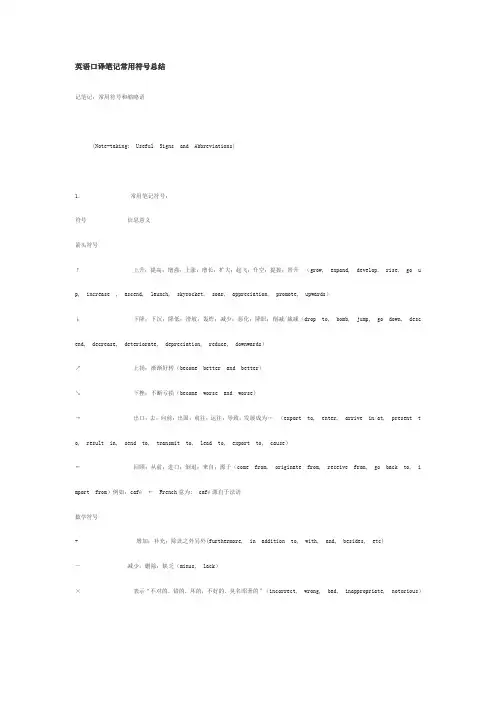
英语口译笔记常用符号总结记笔记:常用符号和缩略语(Note-taking: Useful Signs and Abbreviations)1.常用笔记符号:符号信息意义箭头符号↑上升;提高;增强;上涨;增长;扩大;起飞;升空;提拔;晋升(grow, expand, develop, rise, go up, increase , a scend, launch, skyrocket, soar, appreciation, promote, upwards)↓下降;下沉;降低;滑坡;轰炸;减少;恶化;降职;削减/裁减(drop to, bomb, jump, go down, descend, decrease, d eteriorate, depreciation, reduce, downwards)↗上扬;渐渐好转(become better and better)↘下挫;不断亏损(become worse and worse)→出口;去;向前;出国;前往;运往;导致;发展成为…(export to, enter, arrive in/at, present to, result in, s end to, transmit to, lead to, export to, cause)←回顾;从前;进口;倒退;来自;源于(come from, originate from, receive from, go back to, import from)例如:café← French意为: café源自于法语数学符号+ 增加;补充;除此之外另外(furthermore, in addition to, with, and, besides, etc)—减少;删除;缺乏(minus, lack)×表示“不对的,错的,坏的,不好的,臭名昭著的”(incorrect, wrong, bad, inappropriate, notorious)> 超过,大于,胜过,优于(more than, bigger than, surpass, better than, superior to)< 小于,不足,次于,逊色(fewer than, less than, worse than, inferior to)= 等于符号(equal) 在听力笔记中相当于“与…一样”(equal to, the same as),另外可以表示“是…的对手“(a ri -val, a competitor)等意思。
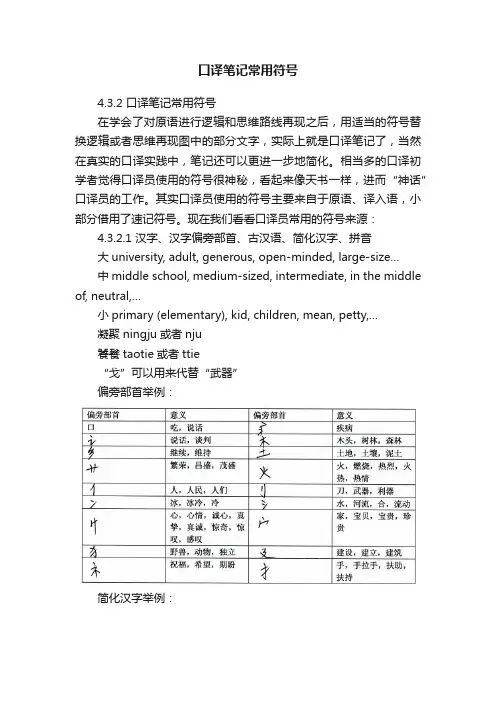
口译笔记常用符号4.3.2 口译笔记常用符号在学会了对原语进行逻辑和思维路线再现之后,用适当的符号替换逻辑或者思维再现图中的部分文字,实际上就是口译笔记了,当然在真实的口译实践中,笔记还可以更进一步地简化。
相当多的口译初学者觉得口译员使用的符号很神秘,看起来像天书一样,进而“神话”口译员的工作。
其实口译员使用的符号主要来自于原语、译入语,小部分借用了速记符号。
现在我们看看口译员常用的符号来源:4.3.2.1 汉字、汉字偏旁部首、古汉语、简化汉字、拼音大university, adult, generous, open-minded, large-size…中middle school, medium-sized, intermediate, in the middle of, neutral,…小primary (elementary), kid, children, mea n, petty,…凝聚ningju或者nju饕餮taotie或者ttie“戈”可以用来代替“武器”偏旁部首举例:简化汉字举例:4.3.2.2 英语、英语字母英语单词的缩写规律:保留单词的辅音,去除元音,当然首字母是元音必须保留。
一般保留三至五个辅音就可以帮助回忆整个单词,例如:impoverishment: impvrdebility: dbltrejuvenate: rjvndepartment: dptstandard: stdreference: rfr口译学习者还需要记住常用国际组织、专用名词、国家名及其首都名的缩写,例如:UN, UNESCO, NATO, APEC, OPEC, …Intellectual property protection: IPPNK, SK, CN, US, UK…口译学习者还可以自己开动脑筋,充分发挥自己的创造性和想象力,开发出简介实用的笔记符号,下面以英文大写字母为例,看看如何创造性地在笔记中使用这些大写字母:A: first, top, excellent, extraordinary, outstanding, remarkable, unusualE: eyesight, economy, economic, economical, electronic, East F: failure, false, wrong, not true, full, flagG: government, GodH: health, help, support, connect, bridge, cross, HourI: I / we, my (our) party, eyeL: long, lengthen, prolongM: money, mail, mother, mountain, movement, McDonald, man, May, Member (ship), mm…N: nose, nation, name, nothing, no, negation, deny, need, necessary, NorthO: zero, circle, old, orange, our, one, empty, world, all, success, completeP: pm, peace, park, pay, politics, people, perfect, president, prime minister, head, flagshipQ: quality, quantity, quarter, question, cute, balloon, head, suspect, doubt, unknown, difficultyR: respect, representative, request, about, relations, returnS: smile, snake, turns and twists, society, social, silence, curve, slimT: time, tea, cross-disciplinary, compound, T-shirt, T-stage, disagreement, dispute, disapprovalU: you (your party), pitfall, trap, recycle, cycle, return, valley V: victory, triumph, vs, valley, bottom, tipW: west, western, wave, fluctuate, ups and downsX: X-ray, XL, wrong, negation, cross, times, execute, killY: why, year, yes, approve, agree, young, deviate, tree, servant Z: zero, zoo, last, zigzag, turns and twists, dream, sleep (comic strip)从以上例子可以看出,我们可以从拼写、发音以及字母的结构等方面来进行联想,在笔记中创造性地使用这些符号。
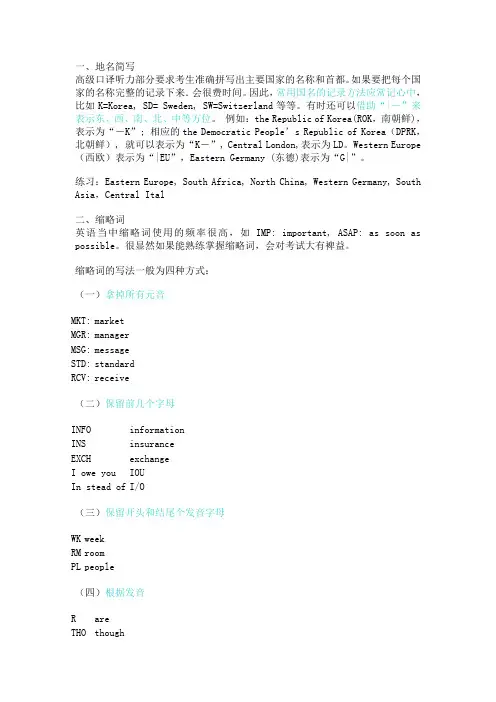
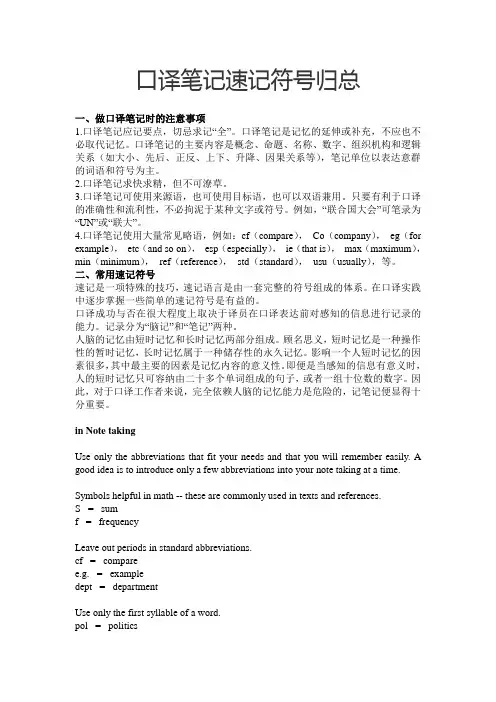
口译笔记速记符号归总一、做口译笔记时的注意事项1.口译笔记应记要点,切忌求记“全”。
口译笔记是记忆的延伸或补充,不应也不必取代记忆。
口译笔记的主要内容是概念、命题、名称、数字、组织机构和逻辑关系(如大小、先后、正反、上下、升降、因果关系等),笔记单位以表达意群的词语和符号为主。
2.口译笔记求快求精,但不可潦草。
3.口译笔记可使用来源语,也可使用目标语,也可以双语兼用。
只要有利于口译的准确性和流利性,不必拘泥于某种文字或符号。
例如,“联合国大会”可笔录为“UN”或“联大”。
4.口译笔记使用大量常见略语,例如:cf(compare),Co(company),eg(for example),etc(and so on),esp(especially),ie(that is),max(maximum),min(minimum),ref(reference),std(standard),usu(usually),等。
二、常用速记符号速记是一项特殊的技巧,速记语言是由一套完整的符号组成的体系。
在口译实践中逐步掌握一些简单的速记符号是有益的。
口译成功与否在很大程度上取决于译员在口译表达前对感知的信息进行记录的能力。
记录分为“脑记”和“笔记”两种。
人脑的记忆由短时记忆和长时记忆两部分组成。
顾名思义,短时记忆是一种操作性的暂时记忆,长时记忆属于一种储存性的永久记忆。
影响一个人短时记忆的因素很多,其中最主要的因素是记忆内容的意义性。
即便是当感知的信息有意义时,人的短时记忆只可容纳由二十多个单词组成的句子,或者一组十位数的数字。
因此,对于口译工作者来说,完全依赖人脑的记忆能力是危险的,记笔记便显得十分重要。
in Note takingUse only the abbreviations that fit your needs and that you will remember easily. A good idea is to introduce only a few abbreviations into your note taking at a time. Symbols helpful in math -- these are commonly used in texts and references.S = sumf = frequencyLeave out periods in standard abbreviations.cf = comparee.g. = exampledept = departmentUse only the first syllable of a word.pol = politicslib = liberalcap = capitalismUse entire first syllable and only 1st letter of 2nd syllable.pres = presentationsubj = subjectind = individualcons = conservativeEliminate final letters. Use just enough of the word to form a recognizable abbreviation.assoc = associatebiol = biologyinfo = informationach = achievementchem = chemistrymax = maximumintro = introductionconc = concentrationmin = minimumrep = repetitionOmit vowels, retain only enough consonants to give a recognizable skeleton of the word.ppd = preparedprblm = problemestmt = estimatebkgd = backgroundgvt = governmentUse an apostrophe in place of letters.am't = amountcont'd = continuedgov't = governmenteducat'l = educationalForm the plural of a symbol or abbreviated word by adding s.chpts = chaptersegs = examplesfs = frequenciesintros = introductionsUse g to represent ing endings.estg = establishingdecrg = decreasingexptg = experimentingSpell out short words such as in, at, to, but, for, and key.Abbreviations or symbols for short words will make the notes too dense with shorthand.Leave out unimportant words.Leave out the words a and the.If a term, phrase, or name is written out in full during the lecture, substitute initials whenever the term, phrase, or name is used again. For example, Center for Aerospace Sciences becomes CAS thereafter.Use symbols for commonly recurring connective or transitional words.& = andw/ = withw/o = withoutvs = against\ = therefore= = is or equalUse technical symbols where applicable.zb = German, for exampleibid = Latin, the same worko = degreesH2O = waterMore reference:Use standard maths, accounting, and science symbols. Examples:+ plus// parallelUse standard abbreviations and leave out full stops. Examples:eg exampleIT dept Information Technology departmentUK United KingdomUse only the first syllable of a word. Examples:mar marketingcus customercli clientUse the entire first syllable and the first letter of the second syllable. Examples:subj subjectbudg budgetind individualTo distinguish among various forms of the same word, use the first syllable of the word, an apostrophe, and the ending of the word. Examples:tech'gy technologygen'ion generalisationdel'y deliveryUse just enough of the beginning of a word to form a recognisable abbreviation. Examples:assoc associatedach achievementinfo informationOmit vowels from the middle of words, retaining only enough consonants to provide a recognisable skeleton of the word. Examples:bkgd backgroundmvmt movementprblm problemForm the plural of a symbol or abbreviated word by adding 's.' Examples:custs customersfs frequencies/s ratiosUse 'g' to represent 'ing' endings. Examples:decrg decreasingckg checkingestblg establishingSpell out, rather than abbreviate short words. Examples:inbutaskeyLeave out unimportant verbs. Examples:iswaswereLeave out unnecessary articles. Examples:aantheIf a term, phrase, or name is initially written out in full during the talk or meeting, initials can be substituted whenever the term, phrase, or name is used again. Example: January Advertising Campaign Budget JACBUse symbols for common connective or transition words. Examples:@ at2 to4 for& andw/ withw/o withoutvs againstCreate your own set of abbreviations and symbols. You may wish to develop separate sets of symbols and abbreviations for different courses or subjects.Other Symbols and Abbreviationsas a result of / consequences of <--->resulting in --->and / also +equal to / same as =following ffmost importantly *less than <greater than > especially esp/一、缩略词英语当中缩略词使用的频率很高,如IMP: important, ASAP: as soon as possible。

现场口译笔记符号汇总一、口译记录符号分类1、像形、会意符号:汉字属于象形文字,具有很强的表意功能,口译记录可以借用单个的汉字或它们的某些偏旁部首,然后再混合其它符号来表达一些概念。
e.g. 水水(上加一横表示干旱,下加一横表示洪灾)“口”表示“国家”、“民族”,在“口”的上面加上一个人头样的小圆圈“o”,这时“口”又可以用来表示"x国人"了2、像声符号:e.g: “U”与单词“you”希腊字母“γ”(gamma) 读作[ga:ma:]其发音近似英语单词“government”的读音,所以“γ”也常被用在口译记录中表示“government”(政府)或“governmental”(政府的)之意。
3、公共场所和行业标识:e.g: “P”,它表示的是“停车场”、“停放”之类的意思,口译记录,我们除了借用这一符号指代上述意义外,还可以将它们稍加引申来表达“中止”、“中断”、“停顿”、“停火”等意思。
再如:作口译记录时我们还可以用“十”来代表“医院”、“门诊部”等。
4、标点符号:e.g: “?”常被用来表示“问题”、“难题”等概念,因此口译过程中若涉及到“台湾问题”时,译员只记作“TW?”即可。
“:”可以表示与“说”有关的概念,如:“告诉”、“演讲”、“宣称”、“声明”、“认为”、“赞成”、“报怨”、“抗议”等;“……”表示“剩余”、“遗留问题”;“( )”则表示“包括”、“在……范围之内”、“封闭”、“闭关自守”、“禁闭”等意思。
、印刷符号:e.g: “∧”则表示“插入”、“干涉”、“介入”、“侵略”,而“/”则用来表示“删(剔)除”、“取消”6、数学符号:加号“+”可以表示“增加”、“补充”;“减号”“-”则表示“扣除”“减少”,而“≈”便用来表示“大约”、“几乎”;“∵”则可以表示“由于”“因为”等概念7、箭头符号:箭头符号直观、明了,使用得更多、更广泛 . e.g:右指箭头“→”常用来表示“派谴”、出国、“运往”、“前往”、“出口”、“向……传达”、“导致”等概念。
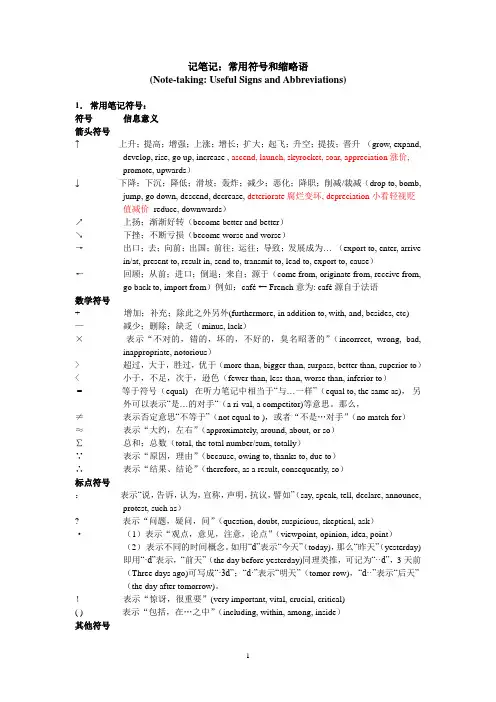
记笔记:常用符号和缩略语(Note-taking: Useful Signs and Abbreviations)1.常用笔记符号:符号信息意义箭头符号↑上升;提高;增强;上涨;增长;扩大;起飞;升空;提拔;晋升(grow, expand, develop, rise, go up, increase , ascend, launch, skyrocket, soar, appreciation涨价,promote, upwards)↓ 下降;下沉;降低;滑坡;轰炸;减少;恶化;降职;削减/裁减(drop to, bomb, jump, go down, descend, decrease, deteriorate腐烂变坏, depreciation小看轻视贬值减价reduce, downwards)↗上扬;渐渐好转(become better and better)↘下挫;不断亏损(become worse and worse)→出口;去;向前;出国;前往;运往;导致;发展成为…(export to, enter, arrive in/at, present to, result in, send to, transmit to, lead to, export to, cause)←回顾;从前;进口;倒退;来自;源于(come from, originate from, receive from, go back to, import from)例如:café← French意为: café源自于法语数学符号+ 增加;补充;除此之外另外(furthermore, in addition to, with, and, besides, etc) —减少;删除;缺乏(minus, lack)×表示“不对的,错的,坏的,不好的,臭名昭著的”(incorrect, wrong, bad, inappropriate, notorious)> 超过,大于,胜过,优于(more than, bigger than, surpass, better than, superior to)< 小于,不足,次于,逊色(fewer than, less than, worse than, inferior to)= 等于符号(equal) 在听力笔记中相当于“与…一样”(equal to, the same as),另外可以表示“是…的对手“(a ri-val, a competitor)等意思。
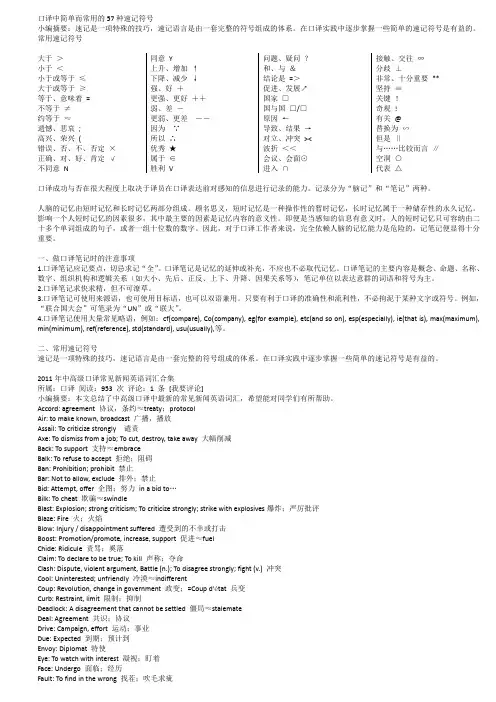
口译中简单而常用的57种速记符号小编摘要:速记是一项特殊的技巧,速记语言是由一套完整的符号组成的体系。
在口译实践中逐步掌握一些简单的速记符号是有益的。
常用速记符号大于>小于<小于或等于≢大于或等于≣等于、意味着=不等于≠约等于≈遗憾、悲哀;高兴、荣兴(错误、否、不、否定×正确、对、好、肯定√不同意N 同意Y上升、增加↑下降、减少↓强、好+更强、更好++弱、差-更弱、更差――因为∵所以∴优秀★属于↔胜利V问题、疑问?和、与&结论是=>促进、发展↗国家□国与国□/□原因←导致、结果→对立、冲突><波折<<会议、会面⊙进入∩接触、交往∞分歧⊥非常、十分重要**坚持≡关键!奇观!有关@替换为∽但是‖与……比较而言∥空洞○代表△口译成功与否在很大程度上取决于译员在口译表达前对感知的信息进行记录的能力。
记录分为“脑记”和“笔记”两种。
人脑的记忆由短时记忆和长时记忆两部分组成。
顾名思义,短时记忆是一种操作性的暂时记忆,长时记忆属于一种储存性的永久记忆。
影响一个人短时记忆的因素很多,其中最主要的因素是记忆内容的意义性。
即便是当感知的信息有意义时,人的短时记忆只可容纳由二十多个单词组成的句子,或者一组十位数的数字。
因此,对于口译工作者来说,完全依赖人脑的记忆能力是危险的,记笔记便显得十分重要。
一、做口译笔记时的注意事项1.口译笔记应记要点,切忌求记“全”。
口译笔记是记忆的延伸或补充,不应也不必取代记忆。
口译笔记的主要内容是概念、命题、名称、数字、组织机构和逻辑关系(如大小、先后、正反、上下、升降、因果关系等),笔记单位以表达意群的词语和符号为主。
2.口译笔记求快求精,但不可潦草。
3.口译笔记可使用来源语,也可使用目标语,也可以双语兼用。
只要有利于口译的准确性和流利性,不必拘泥于某种文字或符号。
例如,“联合国大会”可笔录为“UN”或“联大”。
4.口译笔记使用大量常见略语,例如:cf(compare), Co(company), eg(for example), etc(and so on), esp(especially), ie(that is), max(maximum), min(minimum), ref(reference), std(standard), usu(usually),等。

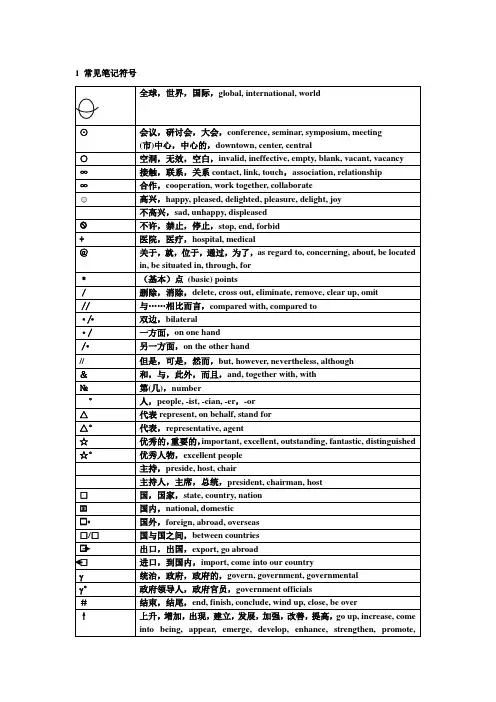
1 常见笔记符号全球,世界,国际,global, international, world≰会议,研讨会,大会,conference, seminar, symposium, meeting(市)中心,中心的,downtown, center, central○空洞,无效,空白,invalid, ineffective, empty, blank, vacant, vacancy∞接触,联系,关系contact, link, touch,association, relationship∞合作,cooperation, work together, collaborate☺高兴,happy, pleased, delighted, pleasure, delight, joy不高兴,sad, unhappy, displeased✠不许,禁止,停止,stop, end, forbid+ 医院,医疗,hospital, medical@关于,就,位于,通过,为了,as regard to, concerning, about, be located in, be situated in, through, for﹡(基本)点(basic) points/删除,消除,delete, cross out, eliminate, remove, clear up, omit∕∕与……相比而言,compared with, compared to·∕·双边,bilateral·∕一方面,on one hand∕·另一方面,on the other hand// 但是,可是,然而,but, however, nevertheless, although&和,与,此外,而且,and, together with, with№第(几),number°人,people, -ist, -cian, -er,-or△代表represent, on behalf, stand for△°代表,representative, agent☆优秀的,重要的,important, excellent, outstanding, fantastic, distinguished ☆°优秀人物,excellent people主持,preside, host, chair主持人,主席,总统,president, chairman, host□国,国家,state, country, nation▪国内,national, domestic∙国外,foreign, abroad, overseas□/□国与国之间,between countries出口,出国,export, go abroad□进口,到国内,import, come into our countryγ统治,政府,政府的,govern, government, governmentalγ°政府领导人,政府官员,government officials#结束,结尾,end, finish, conclude, wind up, close, be over↑上升,增加,出现,建立,发展,加强,改善,提高,go up, increase, come into being, appear, emerge, develop, enhance, strengthen, promote,improve↓下降,减少,着陆,go down, decrease, lessen, reduce, abate, diminish, subside, landing←来自,起源,原因,由……造成,come from, origin, originate from, result from→造成,导致,到达,给,方向,结论是,lead to, result in, go to, arrive at, give,in the direction of, conclude, conclusion∽替换成为,be replaced as, substitute,交流,双向,对话,相互(的),共有的,exchange, two-way, dialogue, mutual, one another, each other≈大约,约等于,大概,差不多,approximate, around, about, approach, close, near, roughly≠不等于,不平等,not equal to, inequality≠分歧,不同点,disagreement, discord, difference=等于,相当于,意味着,be equivalent to, which means><对立,冲突,conflict, clash, opposition↓压力,印象,印象深刻的,pressure, impression, impressed<小于,少于,劣于,回顾,smaller than, less than, worse than, inferior to, look back on, in retrospect, review>大于,多于,好于,展望,larger than, more than, better than, superior than, look into the future, look forward to, prospect≮不小于,不少于,不劣于,not smaller than, no less than, no worse than, not inferior to≯不大于,不多于,不好于,not larger than, no more than, no better than, not superior to+和,加,正面的,多,and, add, addition, plus, positive, a lot, many, quitea few++(比较级) 更,更多,更加,more,+++(最高级) 最多(的),最大(的),最高程度(的),the most-减,负面的,少,subtract, subtraction, minus, negative, few, little--(比较级) 更少(的),更小(的),less---(最高级) 最少(的),最小(的),the least×错误,不好,mistakes, errors, not good√正确,好,correct, good, okayi 工业(的),industry∨胜利,成功(的),victory, success, successful∑总和,合计,total, total amount, total value, add up to, amount to∪(像酒杯) 协议,合约,合同,agreement, treaty, contract∩转换,改变,transform, transition, switch↔属于,belong to∵因为,由于,because, as, for, since∴因此,所以,hence, therefore, so, so that?问题,什么,疑问,question, what, issue, doubt!重要,需引起注意,危险,当心,important, worth attention, danger, caution!!关心,重视,care, emphasize, pay attention to, attach importance to︰说,表明,是,speak, say, shows, demonstrate, be( ) 包括,包含,including, contain, cover, comprise£英镑,pounds$美元,dollars¥人民币,元,金钱,yuan, RMB, moneyY 同意,Y es, approve, agreed 今天,today.d 昨天,yesterdayd. 明天,tomorroww 本周,this week.w 上周,last weekw. 下周,next weeky 今年,this year.2y 两年前,two years ago10y. 十年后,ten years later以上是一些最常见的笔记符号。
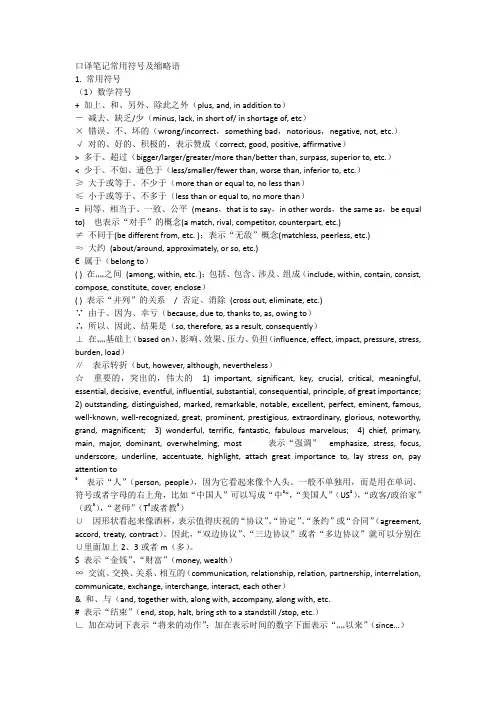
口译笔记常用符号及缩略语1. 常用符号(1)数学符号+ 加上、和、另外、除此之外(plus, and, in addition to)-减去、缺乏/少(minus, lack, in short of/ in shortage of, etc)×错误、不、坏的(wrong/incorrect,something bad,notorious,negative, not, etc.)√对的、好的、积极的,表示赞成(correct, good, positive, affirmative)> 多于、超过(bigger/larger/greater/more than/better than, surpass, superior to, etc.)< 少于、不如、逊色于(less/smaller/fewer than, worse than, inferior to, etc.)≥大于或等于、不少于(more than or equal to, no less than)≤小于或等于、不多于(less than or equal to, no more than)= 同等、相当于、一致、公平(means,that is to say,in other words,the same as,be equal to) 也表示“对手”的概念(a match, rival, competitor, counterpart, etc.)≠不同于(be different from, etc. );表示“无敌”概念(matchless, peerless, etc.)≈大约(about/around, approximately, or so, etc.)Є属于(belong to)( ) 在……之间(among, within, etc. );包括、包含、涉及、组成(include, within, contain, consist, compose, constitute, cover, enclose)( ) 表示“并列”的关系/ 否定、消除(cross out, eliminate, etc.)∵由于、因为、幸亏(because, due to, thanks to, as, owing to)∴所以、因此、结果是(so, therefore, as a result, consequently)⊥在……基础上(based on),影响、效果、压力、负担(influence, effect, impact, pressure, stress, burden, load)∥表示转折(but, however, although, nevertheless)☆重要的,突出的,伟大的1) important, significant, key, crucial, critical, meaningful, essential, decisive, eventful, influential, substantial, consequential, principle, of great importance;2) outstanding, distinguished, marked, remarkable, notable, excellent, perfect, eminent, famous, well-known, well-recognized, great, prominent, prestigious, extraordinary, glorious, noteworthy, grand, magnificent; 3) wonderful, terrific, fantastic, fabulous marvelous; 4) chief, primary, main, major, dominant, overwhelming, m表示“强调”emphasize, stress, focus, underscore, underline, accentuate, highlight, attach great importance to, lay stress on, pay attention to˚ 表示“人”(person, people),因为它看起来像个人头。
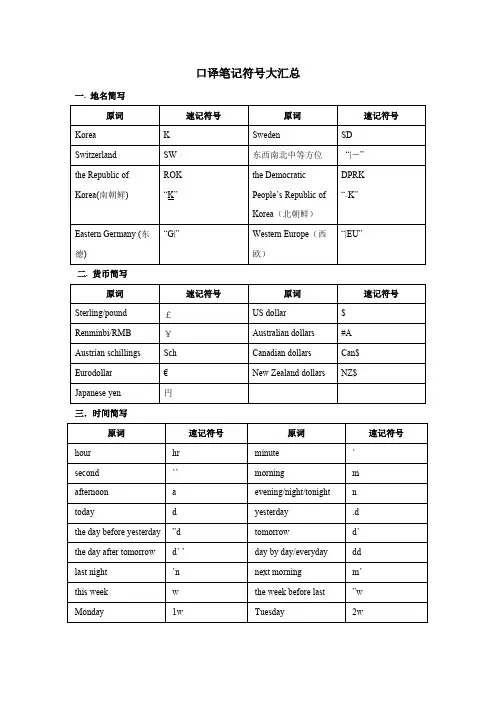
口译笔记符号大汇总一. 地名简写原词速记符号原词速记符号Korea K Sweden SD Switzerland SW东西南北中等方位“|-”the Republic of Korea(南朝鲜)ROK“K”the DemocraticPeople’s Republic ofKorea(北朝鲜)DPRK“_K”Eastern Germany (东德)“G|”Western Europe(西欧)“|EU”二. 货币简写原词速记符号原词速记符号Sterling/pound£US dollar$Renminbi/RMB¥Australian dollars#AAustrian schillings Sch Canadian dollars Can$ Eurodollar€New Zealand dollars NZ$ Japanese yen円三.时间简写原词速记符号原词速记符号hour hr minute’second’’morning m afternoon a evening/night/tonight ntoday d yesterday.dthe day before yesterday”d tomorrow d’the day after tomorrow d’ ’day by day/everyday ddlast night’n next morning m’this week w the week before last”wMonday1w Tuesday2wWednesday3w Thursday4wFriday5w Saturday6wSunday7w this month mJanuary1m February2mMarch3m April4mMay5m June6mJuly7m August8m September9m October10m November11m December12dmtwo month ago.2m this year ytwo year later y2.1949年前/491949年后49/1949年底4920年以后20y|century Csince/ever since┠uo to now/ until┫四.度量衡原词速记符号原词速记符号meter m inch in. centimeter cm foot ftminimeter mm knot ktmile mi acre Anautical mile nm五. 缩略词原词速记符号原词速记符号Apartment APT Accountant ACC According ACDG Accept ACPT Advertisement AD Address ADS aircraft AC at least ALAdvice ADV Approve APVas soon as possible ASAP As much/many as possible AMAPare R Amount AMT Building BLDG Balance BAL Cancel CNCL Conference CNF carbon copy cc care of c/o Conform CFM Commission CMI Complete CMP Concern/concerning/concerned CONC Condition COND Communication CMU Compete/competitive CMPE Certificate CERT Company CO.Departure DPT Discount DISC Department DEPT Extent EXT Exchange EXCH Explain EXPLN Extra large XL Final FNT Flight FLT For your reference FYR Freight FRT Guarantee GUAR Good GD Home office H.O.Interested INTST Information INFO important IMPI owe you IOU In stead of I/OIn view of IVO Include IINCD insurance INS Impossible IMPS Individual INDIV Minimum MIN Market MKT Manufacture MANUF Message MSG manager MGR Model MDL Memorandum MEMO No later than NLT Necessary NCRY Ordinary ORD Observe OBS Obtain OBT Product PROD Patent PAT Packing PKG Please PLS People PLPiece PC Position POSNPossible POSS(BL)Quantity QUTYQuality QLTY room RMRegular REGL Representative REPReservation RESN Repeat RPTResponsible RESPON receive RCVReference REF Situation SITNStandard STD Section SECThough THO TGM TelegraphThanks TKS Telephone TELTrade TRD through THRUTemporary TEMP Traffic TRFTotal TTL You UYour UR Will WLWeek WK Weight WT六.较长单词的处理办法词尾缩写原词速记符号-ism m socialism Sm-tion n standardization (标准化)stdn-cian o technician techo-ing g marketing (市场营销)MKTg-ed d accepted acptd-able/ible/ble bl available avbl-ment mt amendment amdmt-ize z recognize regz-ful fl meaningful mnfl七.字母、图像、符号原词速记符号原词速记符号people/person人o右上角Janpanese日本人JPoGovernment/govern C 政府Governmental official CZPolitics/political P 政治politician PZEfficient/effective G 效率inflation Q 通货膨胀victory,/win/success V 胜利Leader/head T 领导人agriculture/agriculture A 农业business B 商业conflict/confrontation C× 冲突/矛盾work/employ W 工作/职业industry/industrial i 工业treaty/agreement U 合同/协议bilateral(双边的)U内填入2trilateral (三边的)U内填入3 Unilateralism(单边主义)U内填入1Multiple(多边主义)U内填入m谈判破裂U上加一个“/”country/state/nation□国家/民族/领土Import进口gO outport出口Ogchair/ host/preside over Z主持/主办Chairman/host Z°主席、主持人contact, exchanges:∞联系fishery∞捕鱼业head of government/ company CTinternational/worldwide/global/universal ○国际的/世界的/全球的as we all know/ as is known to all/as you have already heard of EO 听到/众所周之meeting/conference/negotiation/seminar/discussion/symposium⊙会议/开会pleasant/joyful/happy/excitedJ 开心/高兴/荣幸/好现象unsatisfied/discomfort/angry/sadL 生气/难过/悲伤/忧虑/不满indifferent/apathetic/unconcern/ don’t care much O 漠不关心/无动于衷total/totally/entire/entirely/onthe whole/all in all/to sum up∑总值/总数go into/arrive at/give to/sendto/present to g→到达/传达lead to/result in/in thedirection of→导致/引导come/go back to/originate←追溯到be/come from/return/receivefromf←自于launch/open/start↗发射/投放市场/发行develop/strengthen/promote/boost,/improve/enhance↑发展/加强/推进up/upward/rise/increase/h↑上升ups and downs/twists and << 波折arise/ascend turns/roller coastersubmit to↓屈服exchange/mutual n交流a match /rival /competitor/counterpart/against VS对手many/lots of/a great deal of/agood many of/plus+ 多/加之/加上/补充more++/+2多的比较级most+3 多的最高级little/few/lack/in short of/be inshortage of/minus -少/减去/除去about/around/orso/approximately≈大约bigger/larger/greater/more than/better than > 大于/多于/好于/优于less/smaller< 小于/少于/差于/劣于superior to/surpass∧高inferior to∨低among/within( ) 在...之间but yet however∧转折cross out/eliminate/ 否定/消除question/issue? 问题/疑惑/难题wonder/miracle/pay attesion to!惊叹/特别注意matchless/peerless无敌say/speak/talk/marks/announce/declare : 说/认为/希望end/stop/halt/bring sth to astandstill/stop∥结束right/good/famous/well-known√对/正确/好的wrong/incorrect/somethingbad/notorious/negative× 错误/失误/坏stand up for/support/ agree withsb/certain/ affirmativeY同意not agree/disagree N不同意thought*想法/重要的/优秀的important/best/outstanding/brilliant☆重要的very/extremely__ 强调程度under the circumstance ̄在…的条件/情况下means/that is to say/in otherwords/the same as/be equal to =即/等于/相当于/同等be different from≠不同/不等于/不相当/不是and/together with/along &和/与belong to∈属于with/accompany/alongwith/further morebasis of/ perpendicular/ isperpendicular to ⊥ …的基础therefore/so/as a result/consequently∴所以/结果because/because of/due to∵因为/由于/多亏hear/listen○3听说about@关于parallel// water H2O for4to2without w/o with w/plus or minus±times x so on, etc, and so forth ···divided by÷circle, circumference○degree℃ellipse0 percent%diameterθper thousand‰triangle, delta △between|.|inside/ within/include/ among,( ) maintaining peace and stability: ◎Empty Oas always/hold on,/persist/ insist on ≡一直/总是/一贯pressure/influence⊥(竖线为向下箭头)On the other hand/or/ 或者right angle∟Representative/delegation/ delegation △ocean/sea/river/lake/brook/stream∽江河湖海水hills/mountainω山climb the mountainω上加一点·山水之间ω∕∽before/beyond/in front of·|above/on/over~上加一点·below/beneath/under~下加一点·table/desk/house/building/bed︹桌/凳/床/楼/房在椅子上︹上加一短横在桌子下︹下加一短横look/ look after/ look into/investigate/witness⊙资本主义资’四个现代化4mpeace-keeping维p第三世界3w。
常用速记符号大于>小于<小于或等于≢大于或等于≣等于、意味着=不等于≠约等于≈遗憾、悲哀;高兴、荣兴(错误、否、不、否定×正确、对、好、肯定√不同意N同意Y上升、增加↑下降、减少↓强、好+更强、更好++弱、差-更弱、更差――因为∵优秀★属于↔胜利V问题、疑问?和、与&结论是=>促进、发展↗国家□国与国□/□原因←导致、结果→对立、冲突><波折<<会议、会面⊙进入∩接触、交往∞分歧⊥非常、十分重要** 坚持≡关键!有关@替换为∽但是‖与……比较而言∥空洞○代表△口译成功与否在很大程度上取决于译员在口译表达前对感知的信息进行记录的能力。
记录分为“脑记”和“笔记”两种。
人脑的记忆由短时记忆和长时记忆两部分组成。
顾名思义,短时记忆是一种操作性的暂时记忆,长时记忆属于一种储存性的永久记忆。
影响一个人短时记忆的因素很多,其中最主要的因素是记忆内容的意义性。
即便是当感知的信息有意义时,人的短时记忆只可容纳由二十多个单词组成的句子,或者一组十位数的数字。
因此,对于口译工作者来说,完全依赖人脑的记忆能力是危险的,记笔记便显得十分重要。
一、做口译笔记时的注意事项1.口译笔记应记要点,切忌求记“全”。
口译笔记是记忆的延伸或补充,不应也不必取代记忆。
口译笔记的主要内容是概念、命题、名称、数字、组织机构和逻辑关系(如大小、先后、正反、上下、升降、因果关系等),笔记单位以表达意群的词语和符号为主。
2.口译笔记求快求精,但不可潦草。
3.口译笔记可使用来源语,也可使用目标语,也可以双语兼用。
只要有利于口译的准确性和流利性,不必拘泥于某种文字或符号。
例如,“联合国大会”可笔录为“UN”或“联大”。
4.口译笔记使用大量常见略语,例如:cf(compare), Co(company), eg(for example), etc(andsoon),esp(especially),ie(thatis),max(maximum),min(minimum),ref(reference),std(stan dard),usu(usually),等。
外交部常用口译笔记符号嘿,你有没有想过,在那些高大上的外交场合,口译员们是怎么迅速又准确地把信息传达出来的呢?这里面可有个小秘密,那就是口译笔记符号。
这就好比是口译员们的“秘密武器”呢!比如说,上升这个概念,我就可以简单地用一个向上的箭头↑来表示。
就像我们看股票走势,如果股票上涨,我们是不是脑海里第一反应就是这个向上的箭头呀?在外交场合中,如果在谈论一个国家的经济增长趋势是上升的,那我就可以迅速地在本子上画个↑,简单又明了。
那下降呢,当然就是一个向下的箭头↓啦。
想象一下,你在和朋友讨论气温的变化,要是说气温降低了,你是不是很自然地就会想到这个向下的箭头?要是在外交谈判里提到某个地区的冲突事件数量在减少,↓这个符号就可以派上用场啦。
还有啊,等于号=。
这在口译笔记里也超级实用。
假如是在说两个国家的贸易额相等或者达成了某种平等的协议,那这个=就像一个小天平一样,准确地记录下这个概念。
这就像我们在分蛋糕的时候,说每个人分到的蛋糕一样多,这个时候等于号就特别能表达这种“相同”的感觉。
大于号>和小于号<也不陌生吧。
在外交事务中,要是提到一个国家的军事力量比另一个国家强大,或者某个国家的资源储量比另一个国家少,这两个符号就能快速记录下这种对比关系。
就好像在一场比赛里,一方得分比另一方多,我们很容易就会想到大于号。
有时候,还会用到一些简单的字母缩写。
像“UN”代表联合国。
这就像我们给好朋友起的昵称一样,简单好记。
在一场国际会议上,如果频繁提到联合国的事务,直接写“UN”可比写“联合国”三个字快多了。
这就像是我们平时聊天的时候,用简称来称呼一些常见的事物,方便又高效。
那像“&”这个符号呢,它可以表示“和”“与”的意思。
比如说在提到中美关系的时候,就可以写成“中&美关系”。
这就好比是把两个好朋友的名字用一个小符号连起来,表示他们之间的联系一样。
这些口译笔记符号啊,就像是一群小小的精灵,在口译员的本子上跳跃着,帮助他们快速地记录下各种复杂的信息。
口译速记符号及范例
在口译过程中,速记是一种非常重要的技能,可以帮助译员更快速、准确地记录和传达信息。
以下是一些常用的口译速记符号及范例,供译员参考。
1.缩写符号
缩写符号是指将一个词或短语的首字母缩写成一个速记符号。
例如:
UN(联合国)
OPEC(石油输出国组织)
VIP(要人)
2.数字速记符号
数字速记符号可以用来表示数量、时间、日期等。
例如:
2000—至今:表示从2000年到现在。
|:用一条线表示一个时间段或过程。
例如:“from 2000—to date”表示从2000年到现在。
1,2,3,…):或递减(10,9,8,…)。
例如:第一名、最后一名等。
3.比较关系速记符号
使用大于(>)和小于(<)符号来表示比较关系。
例如:
5(>5):表示大于5。
小于3(<3):表示小于3。
4.加减运算速记符号
在进行加减运算时使用加号(+)和减号(-)。
例如:
5+3=8(5加3等于8)。
5.百分比速记符号
在表示百分比时使用百分号(%)。
例如:
50%(百分之五十):表示50/100。
6.特殊符号及用法。
口译笔记常用符号及含义∵因为,由于,幸亏,because, for, as, due to, thanks to∴所以,因此,于是,so, therefore, thus, hence, as a result, consequently, accordingly// 但是,然而,不过,相反,but, however, whereas, though, nevertheless, instead, contrast ∫如果,假设,if, once, provided that, in case (of), had I known, were this to happen+ 另外,和,并且,连同,以及,加上,and, as well as, too, plus, add, moreover, besides = 也就是,即,意味着,等同于,which means, that is, in other words, equal to, same, similar ≠不同于,不如,不相当,different, unlike, not the same, unequal≈大约,估计,大概,about, almost, nearly, estimated> 大于,多于,超过,高于,好于,more than, better than, superior to, surpass, exceed< 小于,少于,低于,次于,less than, inferior to↑增长,发展,提高,升级,increase, raise, improve, develop, grow, boost, enhance↓减少,下降,降低,decrease, decline, descend, reduce, cut, fall, drop→导致,引起,引发,到,向,去,to, lead to, cause, result in, bring about, contribute to←由,自,归因于,result from, attributed to, credited to√正确,好,妥善,真实,肯定,good, true, correct, yes, well, positive, confirm, genuine ×错误,不是,否定,无效,负面,坏,bad, wrong, not, negative, false, rather than↔属于,包括,包含,例如,belong to, including, part of, contain, such as, for example∑总和,总数,总之,一句话,结论,sum, all, conclusion, in one word, summary, in brief @ 关于,有关,相关,about, on, relevant, related, concerning, with regard to? 问题,麻烦,难题,疑惑,ask, question, problem, trouble, confused, difficulty, issue! 重要,重视,注意,警告,强调,important, focus, alert, attention, warning, stress, emphasize :说到,表示,提出,认为,想,相信,say, speak, tell, express, think, believe, be sure that <: 看到,了解到,意识到,考虑到,表明,显示出,see, know, show, imply□国家,地区,country, state, nation, region, area,○世界,国际,全球,world, international, global, earth⊙会议,讨论,谈判,meeting, conference, discussion, negotiation, seminar, summith 主持,领导,主席,host, head, leader, chairman, president△代表,represent, on behalf of∽互相,彼此,交换,交流,替代,each other, exchange, mutual, replace 改变,变化,变形,转变,change, alter, transform﹩美元,货币,金钱,财富,dollar, money, currency, fortune﹟结束,停止,暂停,完成,stop, pause, end, finish, complete⊥基础,根本,建立,根据,通过,凭借,based on, establish, according to, through∪同意,认可,一致,协议,联合,agree, agreement, united, union☺高兴,荣幸,激动,乐观,满意,happy, pleasure, excited, privilege, honor, satisfied, luck ☹难过,抱歉,同情,哀悼,后悔,生气,sad, sorrow, grief, sorry, sympathy, regret, angry °右上角标,表示人,者,家,如:中国人中°,Economist E°s右上角标,表示复数概念,如:几年来y s,各国□s_ 放在时间周围表示之前、之中和之后,如:2年前2y ,1年来1y ,6月后6M 放在缩略词或符号下,用于强调或加强语气,如:充分认识到<: ,深表赞同U驻英国大使刘晓明在英国外交部欢迎中国青年代表团招待会上的致辞2010年3月23日尊敬的团中央第一书记陆昊先生,青年朋友们:很高兴出席今晚的招待会。
口 译 笔 记 法 常 用 符 号 (一)数学符号 ∵ 因为,由于,幸亏;because, due to, thanks to, …
∴ 所以,因此,结果是;so, therefore, consequently, …
= 相同,一致,公平;the same as, equal to, similar to, … ≠ 不同,不公平,有差距;difference, disparity, … ≈ 大约,大概;about, almost, nearly, …
﹥ 大于,超过,高于;surpass, exceed, more than, superior to, … ﹤ 少于,低于;less than, inferior to, …
﹢ 另外,多,比较级(上标);plus, add, moreover, besides, … - 减去,除去,除了;minus, deduct, except, …
? 行动,行为,法案;action, act, …
( ) 包括;include, including, …
[ ] 在…之中,在…之内;among, within, …
∈ 属于;belong to, …
× 错的,不好的,负面的;wrong, mistake, bad, notorious, negative, …
√ 对的,好的,积极的;correct, good, positive, affirmative, … (二)惯用符号 : 看,说,想,评论;speak, express, think, … ? 疑问,疑惑,问题是;question, problem, issue, inquiry, interrogate, ask, mystery,… ? 问题;question, problem, …
! 危险,警告,当心,值得注意的是;dangerous, warning, alarm, watch out, of course ° 人,人民,伙伴,朋友;people, partner, …
信息,消息,情报;information, message, intelligence, … 删除,废除,放弃;delete, discard, give up, …
? 贸易,交换,交流,关于,关联,替代;trade, exchange, communication, relationship __ 这个,强调;emphasize a certain word/ phrase.
… 继续,持续,不断的,长期的,各种各样的,多的;more, continuous, … => 加强,推动,促进;enhance, promote, …
×# 不仅;not only, …
& 和,而且;and…
@ 关于;about e.g. 例如,比如;for example, such as, …
(三)图形符号 高兴,激动;happy, pleased, excited, …
失望,不满意,生气;unhappy, unsatisfied, angry, …
会议,聚会;conference, symposium, convention, session, forum, seminar, council, congress, meeting, assembly, gathering, committee, commission, association, union, senate, parliament, convocation, … 学校,大学,教育机构;school, college, educational institution, … 医院,医疗机构;hospital, medical institution, …
○ 全部的,整个的,所有的,完整的,彻底的; complete, whole, … 目标,目的;aim, objective, target, …
? 看到,注意到;see, notice, watch, …
? 重视,强调;pay attention to, highlight, …
□ 国家,民族;nation, state, republic, kingdom, federal, union, … 国际,世界;international, world, …
∧ 领导,顶点,顶级,最高级(上标);top, peak, leader, boss, king, governor, mayor,… 国家领导人,政府首脑;state leader, … 出口;export, … 进口;import, …
△ 城市,都市;city, urban, metropolitan, cosmopolitan, …
▽ 农村,乡村;village, rural, country, countryside, farm, suburb, outskirt, …
☆ 重点,重心,重视,重要的,主要的,杰出的;important, significant, remarkable
* 特征,特点,代表;feature, characteristic, quality, nature, trademark, on behalf of… ♀ 女性;woman, female, … ♂ 男性;man, male, … V 胜利,凯旋;victory, triumph, …
﹩ 美元,钱;有钱的,富裕的;dollar, money, rich, well-off, …
∪ 协议, 决议,合约,条约;agreement, treaty, contract, compact, convention resolution 结束,停止,完成,实现;halt, stop, complete, … ‖ 渠道;channel, tunnel, tube, pipe, ditch, duct, … 发展;development, advancement, … 开放;opening, … ∟ 过去;in the past, long before, past time, … ∟ 将来;in future, in the future, …
↓ 影响,效果,压力,负担;influence, effect, affect, pressure, stress, burden, load,… (四)趋向符号
← 邀请,需要,访问,来到;be invited, needed, come (here), … → 去,到,走;to, go (there)…
↑ 增加,提升,提高,升级,升值;increase, improve, enhance, grow, lift, promote…
↓ 减少,下降,降低,贬值;decline, decrease, reduce, degrade, lower, diminish, … (五)英文字母 y 年;year
M 月;month w 周;week
h 小时;hour
m 分钟;minute
s 秒钟;second
d 日子,今天;day, today
d· 明天;tomorrow .2y 两年以前;two years ago
b 但是;but, however, nevertheless
c 世纪;century
e 经济;economy, economics
f 金融;finance, financial, financially
g 政府;government
h 主持;host, h°即主持人,主席
n 很多个;many, much, several
p 政治,政党,政权;politics, policy, regime, party
r 改革;reform, change, revolution
s 科学,社会;science, scientific, society, social
t 想,认为;think, consider, ponder, suppose, imagine, mediate, deliberate, reckon…
v 胜利,成功;victory, triumph, success, achievement (六)英文小写缩写 al 尽管;although
bz 商业;business
co 公司;company
co社团;communion